Related Research Articles

Coloman the Learned, also the Book-Lover or the Bookish was King of Hungary from 1095 and King of Croatia from 1097 until his death. Because Coloman and his younger brother Álmos were underage when their father Géza I died, their uncle Ladislaus I ascended the throne in 1077. Ladislaus prepared Coloman—who was "half-blind and humpbacked", according to late medieval Hungarian chronicles—for a church career, and Coloman was eventually appointed bishop of Eger or Várad in the early 1090s. The dying King Ladislaus preferred Álmos to Coloman when nominating his heir in early 1095. Coloman fled from Hungary but returned around 19 July 1095 when his uncle died. He was crowned in early 1096; the circumstances of his accession to the throne are unknown. He granted the Hungarian Duchy—one-third of the Kingdom of Hungary—to Álmos.

Zachlumia or Zachumlia, also Hum, was a medieval principality located in the modern-day regions of Herzegovina and southern Dalmatia. In some periods it was a fully independent or semi-independent South Slavic principality. It maintained relations with various foreign and neighbouring powers and later was subjected to Kingdom of Hungary, Kingdom of Serbia, Kingdom of Bosnia, and at the end to the Ottoman Empire.

Salona was an ancient city and the capital of the Roman province of Dalmatia. Salona is located in the modern town of Solin, next to Split, in Croatia.

Solin is a town and a suburb of Split, in Split-Dalmatia county, Croatia. It is situated right northeast of Split, on the Adriatic Sea and the river Jadro.

Tomislav was the first king of Croatia. He became Duke of Croatia c. 910 and was crowned king in 925, reigning until 928. During Tomislav's rule, Croatia forged an alliance with the Byzantine Empire against Bulgaria. Croatia's struggles with the First Bulgarian Empire eventually led to war, which culminated in the decisive Battle of the Bosnian Highlands in 926. In the north, Croatia often clashed with the Principality of Hungary; the state retained its borders and, to some extent, expanded with the disintegrated Lower Pannonia.
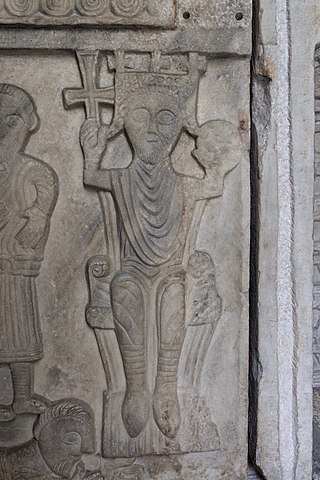
Demetrius Zvonimir was a King of Croatia and Dalmatia from 1075 or 1076 until his death in 1089. Zvonimir also served as Ban of Croatia (1064–1074), and was named Duke of Croatia in around 1075. His native name was Zvonimir, but adopted the forename Demetrius at his coronation.
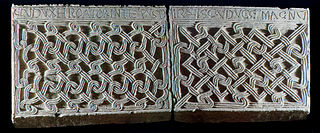
Stephen Držislav was King of Croatia from AD 969 until his death around 997. He was a member of the Trpimirović dynasty.

Nada Klaić was a Croatian historian. She was a Croatian medievalist of the 20th century. A substantial part of the work was devoted to criticism of medieval sources.
Michael of Zahumlje, also known as Michael Višević or rarely as Michael Vuševukčić, was a semi-independent, or independent Slavic ruler of Zahumlje, in present-day central Herzegovina and southern Croatia, who flourished in the early part of the 10th century. Prince Michael of Zahumlje had a common boundary with the Serbia and probably with the Kingdom of Croatia, but was an ally of Bulgaria. He was nevertheless able to maintain independent rule throughout at least a majority of his reign.
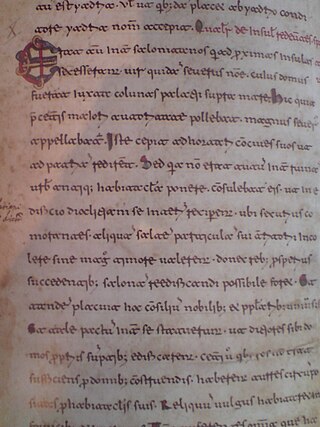
Thomas the Archdeacon, also known as Thomas of Spalato, was a Roman Catholic cleric, historian and chronicler from Split (Spalato). He is often referred to as one of the greatest sources in the historiography of Croatian lands.

The Cathedral of Saint Domnius, known locally as the Sveti Dujam or colloquially Sveti Duje, is the Catholic cathedral in Split, Croatia. The cathedral is the seat of the Archdiocese of Split-Makarska, currently headed by Archbishop Zdenko Križić. The Cathedral of St. Domnius is a complex of a church, formed from an Imperial Roman mausoleum, with a bell tower; strictly the church is dedicated to the Virgin Mary, and the bell tower to Saint Domnius. Together they form the Cathedral of St. Domnius.
Roger of Torre Maggiore or Master Roger was an Italian prelate active in the Kingdom of Hungary in the middle of the 13th century. He was archbishop of Split in Dalmatia from 1249 until his death. His Epistle to the Sorrowful Lament upon the Destruction of the Kingdom of Hungary by the Tatars is a unique and important source of the Mongol invasion of the Kingdom of Hungary in 1241 and 1242.
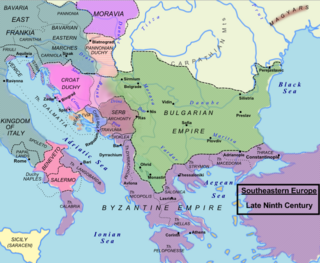
The Duchy of Croatia was a medieval state that was established by White Croats who migrated into the area of the former Roman province of Dalmatia c. 7th century CE. Throughout its existence the Duchy had several seats – namely, Klis, Solin, Knin, Bijaći and Nin. It comprised the littoral – the coastal part of today's Croatia – except Istria, and included a large part of the mountainous hinterland as well. The Duchy was in the center of competition between the Carolingian Empire and the Byzantine Empire for rule over the area. Croatian rivalry with Venice emerged in the first decades of the 9th century and would continue through the following centuries. Croatia also waged battles with the Bulgarian Empire and with the Arabs; it also sought to extend its control over important coastal cities under the rule of Byzantium. Croatia experienced periods of vassalage to the Franks or to the Byzantines and of de facto independence until 879, when Duke Branimir was recognized as an independent ruler by Pope John VIII. The Duchy was ruled by the Trpimirović and Domagojević dynasties from 845 to 1091. Around 925, during the rule of Tomislav, Croatia became a kingdom.
The Battle of Drava River was fought between the army of Tomislav of Croatia and the forces of Hungarian tribes led by Grand Prince Zoltán, the youngest son of Árpád, founder of the Árpád dynasty.

Denis (II) from the kindred Türje or nicknamed Denis the Big-nosed was a powerful Hungarian baron, landowner and military leader in the first half of the 13th century, who held several secular positions during the reign of kings Andrew II and Béla IV. Denis was a childhood friend and staunch supporter of the latter throughout his life. He was the most notable member of the gens Türje.
Peter was a Hungarian prelate in the twelfth century, who served as Archbishop of Split (Spalato) from 1185 to 1190, then briefly Archbishop of Kalocsa from 1190 until his death.

Stephen II was a Croatian–Hungarian prelate of the Catholic Church who served as Bishop of Zagreb from 1225 until his death in 1247.
Ugrin from the kindred Csák was a Hungarian prelate in the 13th century, who served as Archbishop of Split from 1244 until his death.
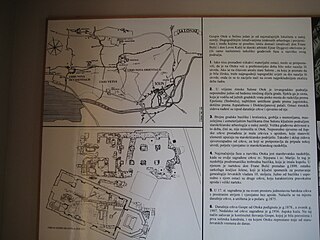
Church of Saint Stephen was a 10th-century church in Salona, currently an archaeological site located in today's Solin, Croatia. Its atrium served as a mausoleum of Croatian medieval rulers. It is one of the two medieval churches on the site, the other being dedicated to the Virgin Mary.
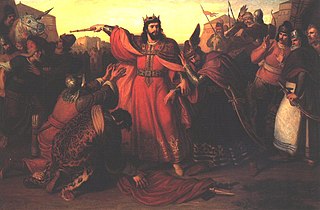
The Brothers' Quarrel was a war of succession within the Árpád dynasty between Emeric, the King of Hungary, and his younger brother, Andrew, Duke of Slavonia. It lasted from 1197 to 1203, covering almost the entire reign of Emeric. The conflict had a significant impact on the development of the 13th-century society and political system in the Kingdom of Hungary.
References
- ↑ Matijević Sokol, Mirjana (2007). "Archdeacon Thomas of Split (1200–1268) – A source of early Croatian History". Review of Croatian History (1): 251–269. Gioanni, Stéphane (2009), The bishops of Salona (2nd-7th century) in the Historia Salonitana by Thomas the Archdeacon (13th century): history and hagiography, in Écrire l’histoire des évêques et des papes, Fr. Bougard and M. Sot (edd.), Brepols, pp. 243-263 [French text].
- ↑ John Van Antwerp Fine (1994). The Late Medieval Balkans. University of Michigan Press. pp. 142–3, 631. ISBN 0-472-08260-4.
- ↑ Florin Curta, Paul Stephenson (2006). Southeastern Europe in the Middle Ages, 500-1250 . Cambridge University Press. p. 17. ISBN 0-521-81539-8.